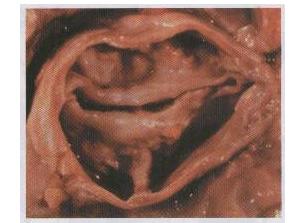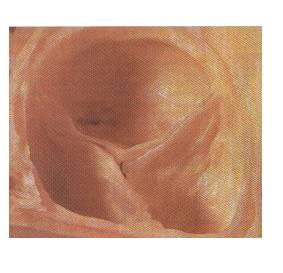Bicuspid aortic stenosis anatomy
|
Bicuspid aortic stenosis Microchapters |
|
Diagnosis |
|---|
|
Treatment |
|
Bicuspid aortic stenosis anatomy On the Web |
|
American Roentgen Ray Society Images of Bicuspid aortic stenosis anatomy |
|
Risk calculators and risk factors for Bicuspid aortic stenosis anatomy |
Editor-In-Chief: C. Michael Gibson, M.S., M.D. [1]; Associate Editor(s)-In-Chief: Varun Kumar, M.B.B.S. [2]
Overview
The Bicuspid Aortic Valve has two cusps: one larger than the other. It is considered unobstructive if the edges of the cusps are free. If the edges are fused or no free the aortic valve is considered obstructive developing a dome during systole.
Anatomy
Bicuspid aortic valve have two distinct anatomical configurations:
- Antero-posterior orientation of the commissures resulting in right and left cusps. This occurs in approximately 53 percent of cases.[1] The right coronary artery originates from the right cusp and the left coronary from the left cusp. The false raphe is present in right cusp.
- 47 percent of patients have commissures on right and left sides of annulus resulting in anterior and posterior cusps.[1] The ostia of both coronary arteries and the false raphe are present in anterior cusp.
There are five varieties of congenitally abnormal aortic valves based on the number and types of cusps and commisures:
- Unicuspid:
- Acommissural
- Unicommissural
- Bicuspid
- Tricuspid:
- Miniature (small aortic ring)
- Dysplastic
- Cuspal inequality
- Quadricuspid
- Six-cuspid
| Here is a bicuspid aortic valve compared with a normal aortic valve: | |
|---|---|
 |
 |